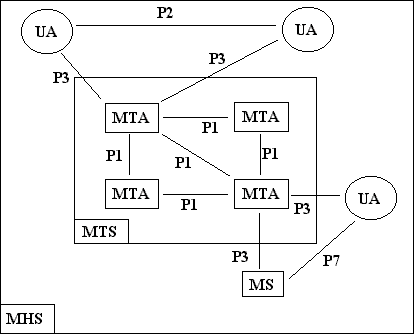X400 is a whole of protocols adapted to EDI
This Web site will bring you information on the standard X400 and its use which is made within the framework of EDI.
An electronic mail consists of a messages distribution between users connected to each other and starting from their workstations data-processing.The Electronic Data Interchange (EDI) can be defined as the exchange between computers concerning trade transactions by using networks and formats approved.
X400 recommendations can be selected like transmission system of data for EDI. The size of EDI files exchanged can be compared to the size of messages exchanged between human.
The series of X400 recommendations define an international standard for structure and transmission of electronic mail messages.
A functional model.
The basic service of X400 electronic mail provides the notification of message not given. When a message cannot be given to a recipient an opinion of not given is generated and turned over to the transmitter.
The service of electronic mail proposes as optional service the generation of opinion of distribution. If the transmitter of a message asks for an defendant of successful handing-over, a report of handing-over is turned over to the transmitter by the MTA which gave the message.
The System of Electronic mail operates in absence of point-to-point connection between the Originator and the Recipient of a message.
The MHS heart is the Message Transfer System (MTS) It is a service of general purpose communications, independent of the applications, and implementing store-and-forward service.
It is composed of message transfer agents (MTA) which cooperate to relay the messages until their destinations.
The MTS operates independently of the type of interchange required by the application and it is transparent compared to the nature of the contents of the message.
An MHS direct user reaches MHS services through an User Agent (UA ) - it is an application which interacts with the MTS to subject and receive the messages.
Messages can be transmited directly by MTS to the UA recipient or in an alternative way can be given to the equivalent of a mailbox which makes it possible to store the messages(MS: Message Store).
MS often co-resides with the MTA which serves it. Using an MS to take delivery of the messages makes it possible the UA not to have a process with the listening which waits to take delivery of the messages.
MS can also subjects and transmits the messages instead of the UA, and notifies to the UA the hour handing-over of the message.
The structure of a message MHS consists of an envelope and contents.
As for a postal mail, the envelope represents the information required by the MTS to give the message such as the address of the recipient.

The protocols X400, architecture of the model
Protocols defined by the standard are :
P1: protocol used for the communication from MTA to MTA.
It can be compared with the address writen on the envelope containing your letter and which allows to carry out the sorting and the routing of the mail.
P2: protocol of interpersonal electronic mail.
Used between two UA, it can be compared to the standards of letters presentation.
P3: access protocol to the MTS
Used for the communication enters MTA and MS or between MTA and an UA.
P7: protocol used between MTA and an UA
who is not directly connected to a MTA. In fact it is very similar to P3, except a service of storage intervenes (using Message Store) - apart from the MTA and the UA.

Conclusion
Considering the complexity of these systems called X400 (by language abuse), there exists currently little of products on the market. The existing products in general propose a subset of the functionalities defined by the standard.
These subsets of functionalities are themselves strictly definied in the X400 standard.